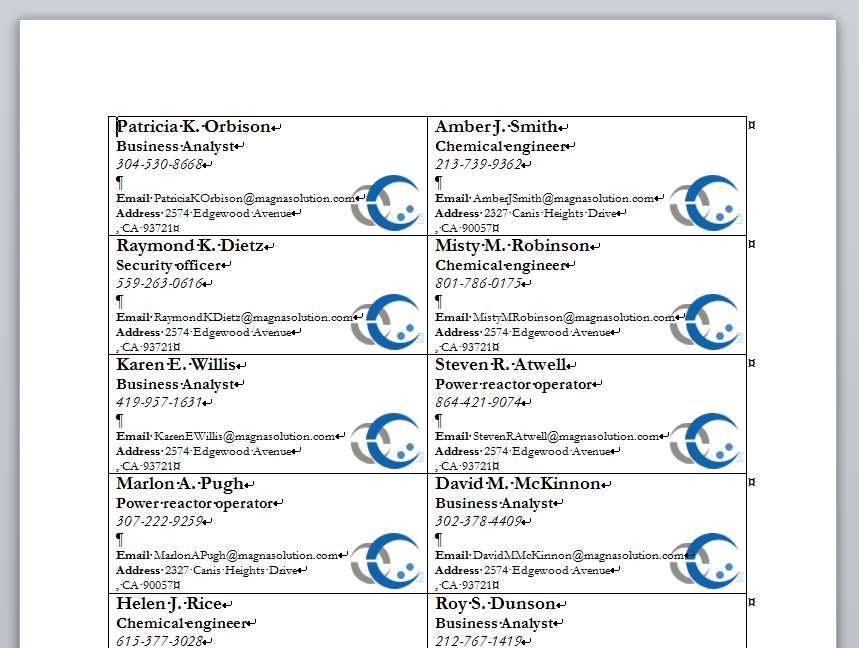...
| Note |
|---|
This tutorial assumes a basic understanding of the |
| Note |
|---|
There is only 1 part to this tutorial. |
The WordTemplate object is used for template-driven document generation. This object opens a WordWriter template file, populates it with data from a specified data source, and generates a new Word document. The WordTemplate object provides the ability to import multiple rows of data by repeating sections of a document for each row, or using the entire document as a repeatable section.
...
| Info | ||
|---|---|---|
| ||
In the downloadable WordWriter_Basic_Tutorials.zip, there is a completed template file located in BusinessLabels/templates/Business_Label_Template.docx. |
...
1. Include the SoftArtisans.OfficeWriter.WordWriter namespace in the code behind
| Code Block |
|---|
using SoftArtisans.OfficeWriter.WordWriter;
|
2. Create a new WordTemplate object and open the template file.
| Code Block |
|---|
WordTemplate WT = new WordTemplate();
WT.Open(Page.MapPath("//templates//Business_Label_template.docx"));
|
...
This call is to a helper method GetCSVData that parses the CSV files and returns a DataTable with the values.
| Code Block |
|---|
DataTable dtBusinessLabels = GetCSVData("//data//BusinessLabelTutorialData.csv");
|
...
Recall that SetMailMerge treats the entire document as a repeat block. This means that the merge fields in the document will need to match the column names of the data source. If there are any stray merge fields in the document, WordWriter will throw an error.
| Code Block |
|---|
WT.SetMailMerge(dtBusinessLabels);
|
5. Process and save the template file.
| Code Block |
|---|
WT.Process();
WT.Save(Page.Response, "Business_Label_Output.docx", false);
|
The completed code should look like this:
| Code Block |
|---|
//Instantiate a new WordTemplate object
WordTemplate WT = new WordTemplate();
//Open the template file
WT.Open(Page.MapPath("//templates//Business_Label_template.docx"));
//Get the order info datatable using GenericParser
DataTable dtBusinessLabels = GetCSVData("//data//BusinessLabelTutorialData.csv");
//Set the data sources to import a single row of data for each source
WT.SetMailMerge(dtBusinessLabels);
//Process to import the data to the template
WT.Process();
WT.Save(Page.Response, "Business_Labels_Output.docx", false);
|
Run the code. You will notice that each employee has a page of business label's labels with that particular employee's data.
...
NEXT fields in the template
1. Place the cursor in the topmost right table cell. This is where the NEXT field will go.
...
By default, NEXT fields will be ignored by WordWriter. To enable NEXT fields, set the WordTemplate.EnableNEXTFields property. This property must be set before WordTemplate.Open is called.
| Code Block |
|---|
WT.EnableNEXTFields = true;
|
Final Code
| Code Block |
|---|
//Instantiate a new WordTemplate object
WordTemplate WT = new WordTemplate();
//NEXT fields will be ignored by default
//This must be set before Open() is called
WT.EnableNEXTFields = true;
//Open the template file
WT.Open(Page.MapPath("//templates//Business_Label_template.docx"));
//Get the order info datatable using GenericParser
DataTable dtBusinessLabels = GetCSVData("//data//BusinessLabelTutorialData.csv");
//Set the data sources to import a single row of data for each source
WT.SetMailMerge(dtBusinessLabels);
//Process to import the data to the template
WT.Process();
WT.Save(Page.Response, "Business_Labels_Output.docx", false);
|
Run the code. The business labels are now populated throughout the page, only moving to the second page after the first page is filled.

Downloads
You can download the code for the Basic WordWriter Tutorials as a Visual Studio solution, which includes the Business Labels tutorial.